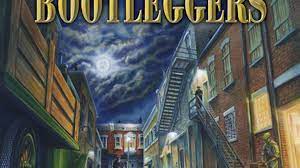On August 10, 1921, the United States was in the midst of the Prohibition era, a period of time when the production, sale, and distribution of alcoholic beverages were illegal. This era gave rise to a network of illicit activities, with bootleggers playing a prominent role in supplying the demand for alcohol. Bootleggers were individuals or groups who engaged in the illegal production and distribution of alcohol during Prohibition. With the passage of the 18th Amendment in 1919 and the Volstead Act, which defined the enforcement of Prohibition, bootlegging became a highly lucrative and widespread enterprise. The ban on alcohol created a significant demand for illicit liquor, as many Americans continued to consume alcoholic beverages despite the legal restrictions. Bootleggers took advantage of this demand by manufacturing and smuggling alcohol through various means. One of the primary methods employed by bootleggers was the production of homemade alcohol, often referred to as "moonshine." Moonshine was produced in hidden distilleries or makeshift stills in remote areas, away from the prying eyes of law enforcement. These homemade spirits were often of questionable quality and potency, as the production methods lacked regulation and quality control. To evade authorities, bootleggers would transport their illegal alcohol through covert means. They would hide the contraband in secret compartments in vehicles, boats, or even on their person. Some bootleggers resorted to more elaborate methods, such as smuggling liquor across the U.S.-Canada border or using underground tunnels to transport alcohol discreetly. Bootleggers also relied on a network of speakeasies, which were secret establishments that served alcohol illegally. These hidden bars and clubs operated clandestinely, often requiring a secret password or invitation for entry. Speakeasies became social hubs where people could gather to drink, socialize, and enjoy entertainment. The illegal alcohol trade during Prohibition attracted a diverse range of individuals to the bootlegging business. Some were small-time operators, while others were part of organized crime syndicates. Notorious gangsters like Al Capone became synonymous with bootlegging, using their wealth and influence to control the illicit alcohol market. Despite the efforts of law enforcement, bootlegging thrived during the Prohibition era. The demand for alcohol remained high, and the profitability of the trade enticed many to participate. The illegal alcohol industry generated vast sums of money, leading to corruption within law enforcement agencies and government officials. The era of bootlegging came to an end with the repeal of Prohibition in 1933. The 21st Amendment effectively ended the ban on alcohol, bringing an end to the lucrative illegal alcohol trade. Many bootleggers transitioned to legal alcohol production or other criminal activities, while others faded into obscurity. The bootlegging era left a lasting impact on American culture and history. It highlighted the country's complex relationship with alcohol and the limits of government control. The era also gave rise to new social dynamics, as speakeasies became symbols of rebellion and the flouting of societal norms.
10 Aug, 1921 U.S.A. Bootleggers
